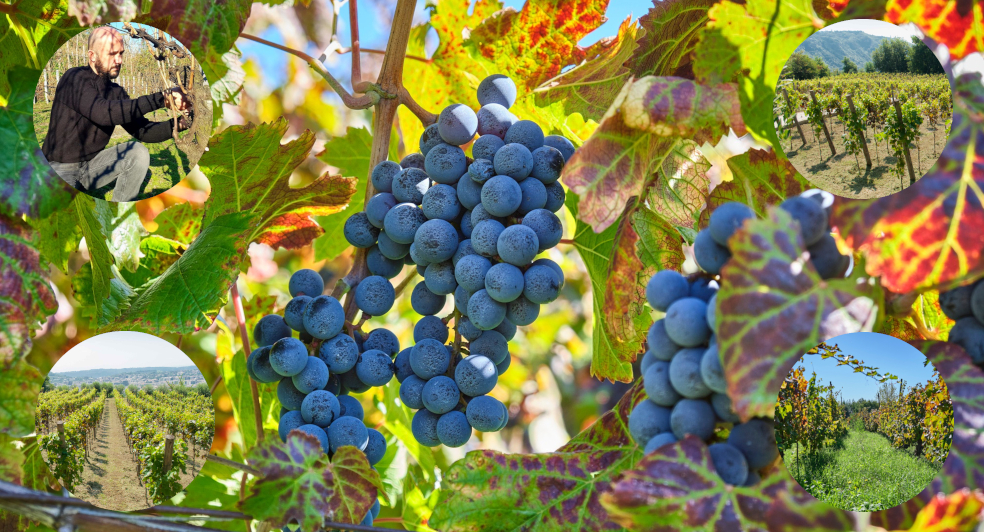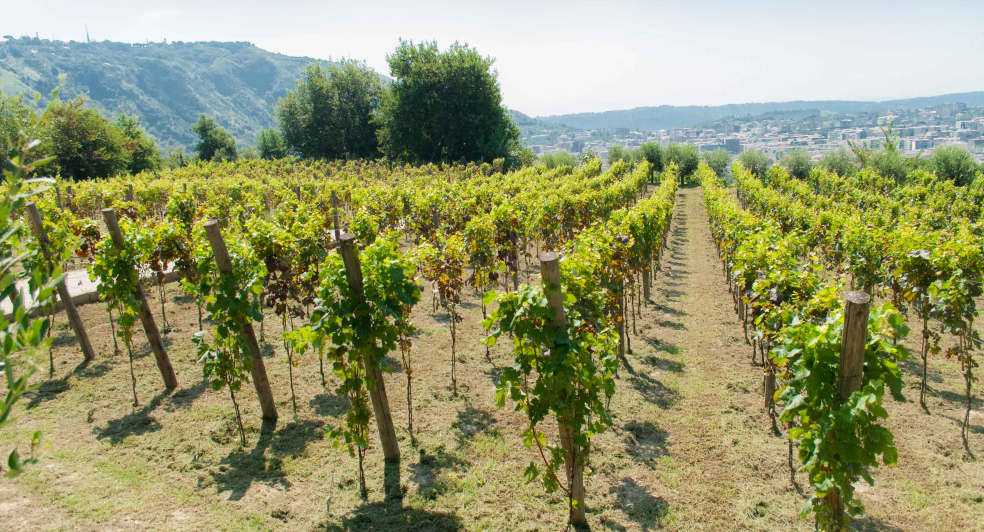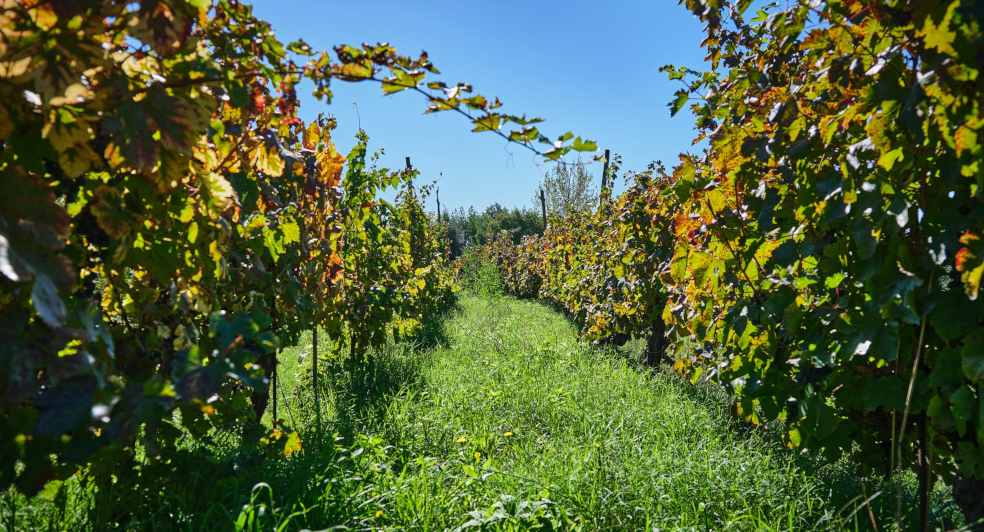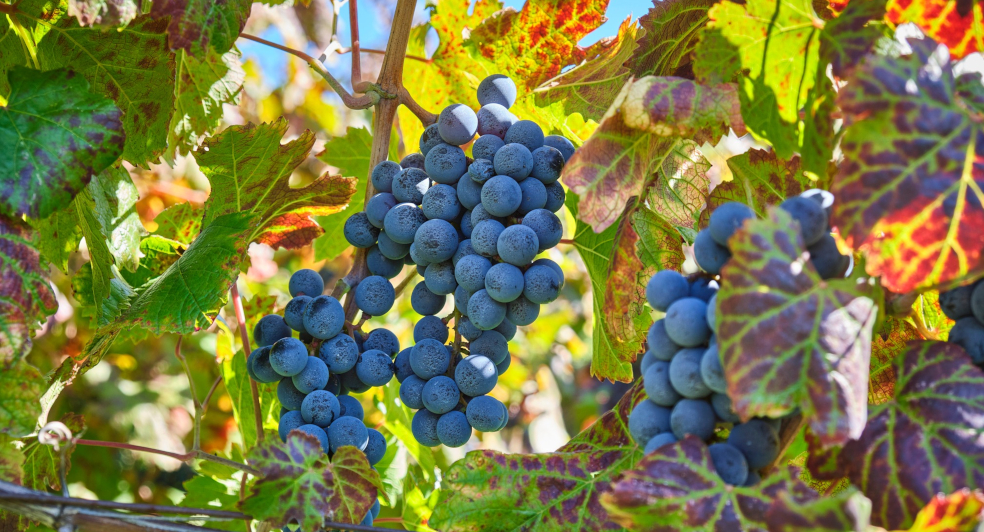The Phlegraean Fields and Sparkling Wines
7th March 2023

The Phlegraean Fields (Campi Flegrei in Italian) is an active volcanic area located just northeast of Naples in Italy with a rich viticultural heritage. Urban heroic viticulture and winemaking are a bit of a hidden gem among the chaos of traffic, houses, and the dense population. The last time I was there, I woke up in the morning, opened the balcony doors in my hotel room, and was amazed by the stunning view of the Gulf of Naples, Vesuvius, the islands of Capri and Ischia, and beyond. It is a place where the inner flaming fire of the earth meets the pure blue of the sky and sea.
When it comes to wine, the Phlegraean Fields are mostly known for their white Falanghina and red Piedirosso and Aglianico wines. However, the wine producers in the area also make sparkling wines with a strong character. Let us discover more below.
But, first, a bit of history…
The Phlegraean Fields in Ancient History

Phlegraean comes from the Greek word Flegraios which means “Burning fields,” and it was a name the first ancient Greek settlers gave to the area in the 8th century BCE. The “burning” does not refer to volcanic eruptions but rather to the presence of many fumaroles that consistently puff out hot gases and vapor. The Phlegraean Fields is a supervolcano in the form of a collapsed caldera formed 39,000 years ago that contains 24 craters scattered around the area.
The Dark Side of the Phlegraean Fields

The “burning” from within gives it an air of both mystique and beauty, and according to ancient Greek mythology, it was the site of the underworld where Hades had imprisoned the giant Titans. Likewise, Dante considered the Fields the entrance to hell. In fact, the famous sentence in Inferno, “In the middle of the journey of our life, I came to myself, in a dark wood, where the direct way was lost,” is believed to allude to Lago d’Averno and the forest between Cuma and Naples.
Many authors and poets have written about the Phlegraean Fields throughout history other than Dante, such as Homer, Virgil, Milton, and Goethe. For example, during his travel through Italy at the end of the 18th century, Goethe defined the Fields as “the most marvellous region of the world, under the purest of skies and the most perfidious of terrains.”
The Terroir of the Phlegraean Fields

The Phlegraean Fields are remarkable for their combination of geological, environmental, and climatic factors, creating a unique terroir suitable for viticulture and winemaking. Oenologist and winemaker Gerardo Vernazzaro of Cantine Astroni says it is a terroir with “volcanic soil of recent pedogenesis with great fertility, soils rich in potassium, and close to the sea.” However, he continues to underline that we are talking about coastal viticulture, where there is an essential saline influence in the wines that stems both from the soil and the sea. Furthermore, he believes that the azure sea and the fiery red of the volcanic ground produce wines “suspended between the craters and the sea.”
Cantine Astroni is located right in the heart of the Phlegraean Fields, just next to the Astroni crater. The Varchetta family founded the winery in 1999, but they have been wine merchants for over four generations since 1892. Today, the three cousins, Cristina Varchetta, Vincenzo Varchetta, and Gerardo Vernazzaro, run the winery together. Gerardo manages the vineyards and the winemaking, Vincenzo, also an oenologist, runs the commercial aspect, and Cristina takes care of the wine tours and hospitality. From the beginning, their focus has been to communicate the unique characteristics of the Phlegraean Fields and to safeguard the local viticultural tradition, native grapes, and sustainability.
If we look closer at the soil, the volcanic earth in the Phlegraean Fields is white, sandy soil rich in potassium, magnesium, and phosphorus, all essential for plant growth. Mara Portolano of Mario Portolano winery says the volcanic soil likewise consists of lapilli (volcanic fragments), ashes, and yellow tuff. These help to retain heat and provide a warm environment for vines to grow. The sandy soil is also why the phylloxera never affected the Fields in the late 19th and early 20th centuries, as aphids cannot survive in very sandy soils.
The siblings Mara and Stefano Portolano are running their small winery with 5,5 hectares of vineyard together in the Toiano neighborhood close to Pozzouli. From the vineyard, you have the terraces with centenary-old vines behind you and Vesuvius and the sea in front of you. The Portolano family is from Naples, where they, for several generations, have been making haute couture leather gloves. Their father, Mario Portolano, had a special passion for the countryside and decided to buy a farmhouse with land years ago. At this country house and the surrounding vineyards, they make terroir-driven wines in his honour today.
Falanghina and Piedirosso

Falanghina and Piedirosso are the two primary grape varieties that identify the Phlegraean Fields. They are also grown in other areas of Campania. Still, they have a particular connection to the Fields, according to Mara Portolano, due to the volcanic soil and its proximity to the sea. Both are very ancient grapes that have already been documented, for example, by Pliny the Elder in his “Naturalis Historia” in the Roman era.
DNA studies have shown that Falanghina Flegrea is a different clone than the Falanghina grown in Benevento. Gerardo Vernazzaro stresses that the specific terroir of the Fields mentioned above gives “saltiness, minerality, and elegance” to the wines as well as a lower alcohol level. He continues to say that Falanghina grown in the “lower and less exposed” areas of the Fields, is suitable for sparkling wine if picked early at the end of August or the beginning of September.
In the past, Piedirosso was usually used in blends with Aglianico to soften the latter, but more recently, wineries have started to make monovarietal Piedirosso wines. According to Gerardo Vernazzaro, Piedirosso is very late to mature in the sandy and warm volcanic soils of the Phlegraean Fields, being harvested toward mid-October. The Piedirosso wines here are mineral and elegant with intense aromas.
Three Sparkling Wines from the Phlegraean Fields

Cantine Astroni, Cantine Federiciane, and Mario Portolano make three different kinds of sparkling wines that are all, in their own way, an expression of the terroir of the Phlegraean Fields.
Astro Extra Dry Campi Flegrei Falanghina Spumante, Cantine Astroni (Charmat method)
Complex and elegant, with intense notes of white flowers and fruit. A persistent perlage that lingers on your palate. The freshness and minerality make it the perfect companion while enjoying an aperitif at the patio of the Astroni winery.
They are also working on making a Falanghina sparkling wine with the Champenoise method that they will launch in the future. They have bottles on the lees for the moment in the cellar.
Flegreo Rosato, Campi Flegrei, Cantine Federiciane (Charmat method)
A Piedirosso sparkling rosé wine with a lovely raspberry-like colour that makes you happy. It has fresh fruit-forward notes of wild strawberries and raspberry. Acidity and minerality that is so typical for the Phlegraean Fields. It is a sparkling wine to have handy on a warm summer day.
They are also working on making a Falanghina sparkling wine with the Champenoise method that they will launch in the future. They have bottles on the lees for the moment in the cellar.
Maior, Spumante Metodo Classico, Campi Flegrei, Mario Portolano
Mara and Stefano have only recently started experimenting with making a 100% Falanghina sparkling wine with the Champenoise method. They harvest the Falanghina about a month early to maintain the acidity and the minerality. When I last visited Mara and Stefano, the Maior was not yet released to the market because they had not decided on the label.
It is a beautiful sparkling wine with a persistent perlage, freshness, minerality, and structure, evoking the extraordinary soul of the volcanic Phlegraean Fields.
![]()
Katarina Andersson
An ex-academic with a Ph.D. in history turned wine writer. She also has a sommelier diploma. She loves history and telling the story about the people behind a wine, a winery or a region.
